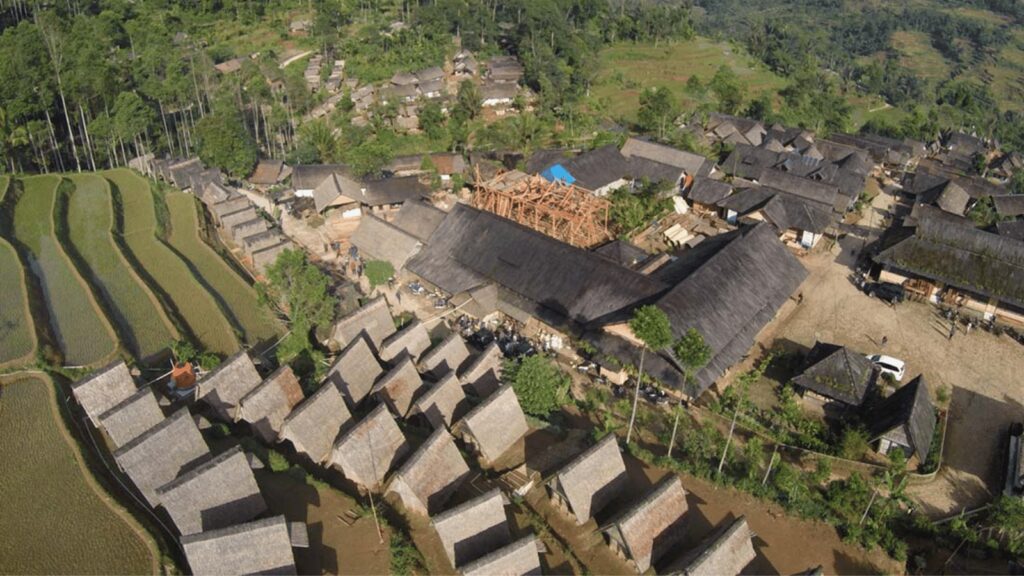Kasepuhan Ciptagelar : A local wisdom managing environmental sustainability that hypnotises adventurers
Founded in 1368, this village, which is located at an altitude of 1,050 meters above sea level, has temperatures ranging from 20 – 26 degrees Celsius – still firmly holding on to the customs and teachings of their ancestors, such as the characteristics of the location, the shape of the house, and several other traditions that govern life.
RELEVANT SUSTAINABLE GOALS


Kasepuhan Ciptagelar
Kasepuhan Ciptagelar, a documentary film by Watchdog, tells the story of a village called Ciptagelar. Located in West Java, Indonesia, Ciptagelar is a village that has succeeded in becoming independent. One thing Watchdog highlighted through this documentation; there is little environmental pollution in Ciptagelar village, and the village economy is self-sufficient, especially in agriculture. However, the accomplishments achieved by going against the flow of globalization, namely the flow of interdependence between people. Less pollution and a self-sufficient economy happen because the Ciptagelar people believe in their values to save their lives. One of the values that the villagers believe in is that rice is people’s life. With this value, the community appreciates rice and creates a rice surplus in their village. If the village community abandons this value, there will be no rice surplus in Ciptagelar village
The people of Kasepuhan Ciptagelar still cling to their traditional values and pass down their customs from generation to generation. The customary institutional structure is inherited through heredity, and each customary is led by a Sesepuh (elder). That’s why the community highly filters technological developments. The Ciptagelar community uses technology sufficiently to build their village. Their agriculture does not use high-tech and relies on less-prime seeds that are harvested once a year yearly. Although the harvest is only once a year, the crops can meet the community’s self-sufficiency needs. The traditional way of the Ciptagelar community used in agriculture shows that there are limitations that make people creative. Ciptagelar people managed to keep up with the times with their limitedness.
How Do They Maintain Survival ?
There are three pillars of sustainability to achieve a sustainable community; economic vitality, environmental quality, and social equity. To fulfill the three pillars’ conception, the customary stakeholders of the Ciptagelar village make three land-use; hutan titipan, hutan tutupan, and hutan garapan. Hutan titipan (entrusted forest) is a forest area guarded and protected by humans (in this case, Ciptagelar people) and the guardian spirit of the first. It’s forbidden for anyone to enter and take things without the elder’s permission. That means the community deliberately protects and guards the forest to maintain the balance of people’s lives. Hutan tutupan (protected forest) is a forest where the community can only take non-timber forest products like honey, mushrooms, spices, and roots (medicine and spices). If urgent and the situation is compelling, cultivation in the protected forest must be based on the interests and needs of the entire Kasepuhan Ciptagelar community. Meanwhile, in the hutan garapan (cultivated forests), people are only allowed to do activities for farming, gardening, building houses, roads, and places for worship, funerals, and grazing.
The Ciptagelar people have inherited the natural surroundings and traditional lifestyles from their predecessors that have maintained them. Therefore, the principle makes all Ciptagelar villagers live a traditional lifestyle without relying on modern technology in their daily life; activities are carried out organically and are very beneficial for the environment to maintain the sustainability and cleanliness of the village environment.
How can we learn from the Ciptagelar village?
In conclusion, the Ciptagelar community successfully implemented the three pillars of sustainability:
- They have maintained economic vitality by creating a self-sufficient economy.
- The Ciptagelar community has maintained environmental quality by protecting the environment from exploitation and third parties from tempering.
- They have gained social equity where the community benefits from the economic opportunities and a shared environment.Community activities are carried out organically and are very beneficial for the environment to maintain the beauty of the village.
Nowadays, nature and the economy are perceived as competing with one another in terms of human well-being and a healthy environment. However, this trade-off only works in the short term. There will be no decent jobs on a dead planet.
The interdependence between economic well-being and nature presents an enormous opportunity, placing both human well-being and a healthy environment as one goal while simultaneously creating a better economic system. Creating and using nature-based solutions can help address the crisis of nature and climate while creating jobs and prosperity. Creating and using nature-based solutions can help address the crisis of nature and climate while creating jobs and prosperity. For example, restoring forests, building green infrastructure, practising agroecology, or creating urban forests. Many practical and implementable nature-based solutions can be deployed to protect and enhance nature while creating, sustaining, or enhancing decent employment, simultaneously contributing to the achievement of the Sustainable Development Goals (SDGs).
You may also be interested in :
World Cleanup 2022 : Largest Cleanup Campaigns Happening Soon


